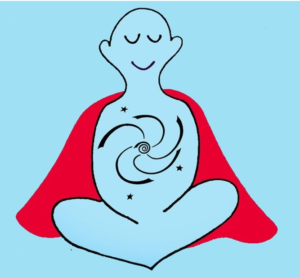Practice #2: The Inner Smile
The “inner smile” is a foundational practice within the entire Qigong system. As said by Mantak Chia:
“The inner smile… is so close to the root of the root. By this I mean the Inner Smile is so close to the root of inner alchemy, and inner alchemy is the root of all the other Tao systems, even the I Ching.”
Chia, M. (2003). Foreword: Inner Smile – Root of the Root. In M. Winn, The way of the inner smile (pp. 1–2). Dao Alchemy Research Institute.
The basic idea of the inner smile, and the reason why it is so foundational, is that it is about absorbing your attention within your body… with the special quality of the smile.

The smile is indeed a very special kind of energy – its effect on us is unparalleled. When we walk down the street and see a friend, and exchange smiles with them, it uplifts us straight away, energising us and making us feel happy. This is a very special power we have. According to Taoism, the energy of our smile comes directly from our spirit (which explains why it has such power). So, when we work with the inner smile, what we are really doing is directing our spirit power into the body.
We literally ‘light up’ our insides by the power of the smile. When placed on our organs, bones and tissue, this energy strengthens them, which turn makes us feel even better – and so an inner ‘feedback-loop’ is created – a ‘self-feeding’ circuit. We smile inwardly, we feel good as a result, and as a result of feeling good, we smile more, and so on… and so this self-feeding loop expands; the result is lightness, happiness and a feeling of well-being.
Therefore, this practice is a powerful technique for cultivating inner harmony, relaxation, and self-love. By consciously directing a gentle, genuine smile inward, we nourish our body, calm the nervous system, and create a deep sense of well-being.
This process can be thought of as a form of “emotional engineering” — a deliberate way to shift our internal state toward greater positivity. Just as an architect carefully designs a structure for strength and stability, we can engineer our emotions by activating a smile from within. In doing so, we take an active role in shaping our emotional landscape, reinforcing a sense of peace, gratitude, and joy within the body.
Modern science has confirmed what ancient Taoist wisdom has long understood—smiling doesn’t just reflect happiness; it also creates it. Numerous scientific studies have demonstrated that smiles are bi-directional, meaning they work both ways:
- When we feel happy, we naturally smile—a reflection of our inner emotional state.
- But the reverse is also true—when we smile, it signals the brain to feel happier, even if we weren’t happy to begin with.
This happens because smiling activates the brain’s reward system, triggering the release of dopamine, serotonin, and endorphins — the body’s natural feel-good chemicals. A genuine smile, especially a ‘Duchenne Smile’ (which engages both the mouth and the muscles around the eyes), has been shown to:
- Reduce stress hormones like cortisol.
- Lower blood pressure and support heart health.
- Enhance emotional resilience and decrease feelings of anxiety.
- Promote relaxation and an overall sense of well-being.
By practicing the Inner Smile regularly, we learn to generate happiness from within, rather than depending on external circumstances. This makes it a truly empowering practice, putting us in control of our emotional state and overall well-being.
The deeper purpose of the technique is the saturation of attention within the body. Ultimately, our aim is to be 100% aware of every cell of our whole bodies at all times. As mentioned in the theory section above, the goal of the entire system is to be able to draw the bio-energy of every cell in the physical body into the energy body, thereby giving it the ability to appear solid. To do this, one needs to be in touch with every cell in the body.
Practice Guide
The basic idea of the technique is to direct the smile to various parts of the body on the in-breath, and then, on the out-breath, to feel those parts of the body smiling back. The technique is provided in the video attached.
- A note on posture: The recommended posture for this exercise is seated. If you can take a cross-legged position, please do so, however, it is not necessary. If you are not able to sit cross-legged, then sit on a chair, with your sit-bones just near the edge of the chair, so that you are sitting up straight, balancing on your sit-bones, without leaning back on the chair. Your knees should be at the same height as or below your hips to ensure that the spine is straight. Place your hands on your knees, either with palms up or down. Relax your shoulders and close your eyes. Breathe in and out through your nose (unless your nose is blocked, in which case, open your mouth to breathe). [Further notes on posture for the seated exercises are provided later in this course.]
[INSERT VIDEO]
A written description of the exercise is provided at the Exercise File tab.
After you have completed the exercise, please take a moment to sit quietly and observe the effect of the practice. Write down what you experienced in your Course Journal.
